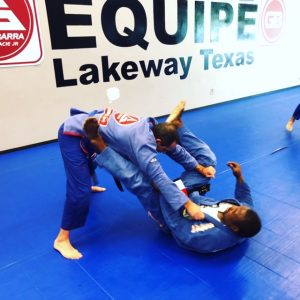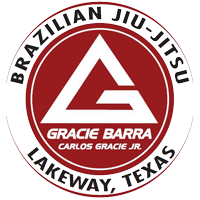Adults Fundamentals Jiu-jitsu at Gracie Barra Lakeway
The Adults Fundamentals Jiu-jitsu class at Gracie Barra Lakeway is the core of our school. The purpose of the Adults Fundamentals classes are to create the beginnings of a foundation in Brazilian Jiu-jitsu and Self-Defense. The class is structured to facilitate the best learning environment possible and is great for all students, regardless of rank.
Overview
At the beginning of each class, we provide a structured and safe-for-all-levels warm-up. After warming up for 6-8 minutes, either a self-defense or standing technique (usually Judo for this class) is taught. The purpose of this is to teach students how to defend themselves on their feet (where most fights begin) and further, how to bring an altercation to the ground where Jiu-jitsu is highly effective. This part of the instruction will take up the first third of class.
Once we hit the ground, we move our instruction towards the most basic positions, including both top and bottom of each:
Positional Techniques
Guard: This is a position where the legs of one practitioner are either in front of or wrapped around the other. The goal of this position is to use your legs to get a submission or get into the top position (from the bottom). If you are on top, the goal is to get passed the legs (a position of strength for the bottom practitioner) and end up in a control position or a “pin” as it is described in Judo or Wrestling.
Side Control: This is usually the first of the basic pins after the guard has been passed. A side control position is characterized by one practitioner laying perpendicularly across the other who is flat on their back. Thus, the practitioner on top can use his/her bodyweight combined with other control tactics to keep the person on bottom immobilized. The goal for the top practitioner is to submit their partner or advance the position. This is one of the ways Jiu-jitsu differentiates itself from wrestling. In wrestling and many times in Judo, a “pin” ends the match. In Jiu-jitsu, we seek to move forward and seek more advantageous positions. The goal for the partner on bottom is to reverse the position (end up on top) or “recover guard” where the practitioner is able to get his/her legs back in front of the other.
Mount: The mount position is hierarchically one of the two most dominant positions in Brazilian Jiu-jitsu. This position is characterized by a practitioner sitting over the top of another, hips pinned by their hips, knees underneath their shoulders. The nature of this pin is such that the person on bottom is essentially being “sat on” and cannot use the hips or shoulders very effectively. This position requires patience and calmness as the person on top seeks to either maintain control of the position OR advance with a submission.
Back: The back position is the other of the two most dominant positions in Brazilian Jiu-jitsu. In my personal opinion, the back is worse than the mount only because our strength, as human beings, is in front of us. When a jiu-jitsu practitioner has his/her back taken, they must maneuver their bodies into a safer position to avoid submissions. This is much easier said than done.
“Specific Training”
After our technical instruction, we move towards the last part of class: Specific Training. This is a fun and effective way to learn all of the techniques we have just practiced in a live application. We are not “sparring”, where the positions will vary, but rather, starting and ending in the same positions we have just learned in order to keep the training environment more controlled (read: less variables). This allows practitioners with little to no experience practice safely and stay in a realm of comfort until they are ready to begin sparring.
If you are interested in learning more, do not hesitate! Please email me here (Contact form link)


You can also find more information about our All Levels Program (coming soon and our NoGi program here!

Comments are closed.